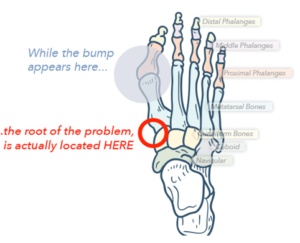Bunions: More Common than Realized
January 29 2023
Did you know that 23% of people between 18-65 years old have bunions?
Dr. Mustafa discusses surgical options for treating bunions. #bunions #podiatrist #FFLC
Bunions are one of the three most common foot ailments, along with plantar fasciitis and Morton’s neuroma. Bunions affect 10-25% of the population; approximately 23% of people 18 to 65 years old have bunions. They are more prevalent in seniors and women; children also can develop bunions.
Eventually, the big toe will position itself over or, more commonly, under the second toe, which can then develop into a hammertoe. The ensuing discomfort alters the gait, causing even further deformity, increased irritation from shoes rubbing on the tender areas, and chronic pain. And the vicious cycle is established. Over time, the big toe may lose mobility. Bunions also can cause sores between the toes and ingrown toenails.
Some of the factors that exacerbate the tenderness and persistent irritation of a bunion include:
- High-heeled shoes – Statistically, women are 10 times more likely than men to develop bunions. Women’s tight-fitting and pointy-toed shoes often get the blame for causing bunions; experts say this is not the case.
- Standing on feet all day – teachers and nurses are more susceptible
- Being overweight
- Spending long periods of time on hard surfaces
- Ill-fitting footwear
- Repetitive stress – ballet dancers often suffer from bunionsSurgical ManagementSome people suffer for years, getting cortisone injections, icing every day, taking anti-inflammatory medications. When you’ve replaced your entire shoe wardrobe and can’t remember the last time you exercised, you’ve waited too long. It’s time for surgical intervention.
The goal of bunion removal surgery is to repair the underlying deformity, correcting the angle of the bone(s) while minimizing the chance of the bunion coming back.
There are two very common methods of surgical treatment for bunions: osteotomy and fusion surgery.
During and osteotomy procedure, your orthopedic surgeon makes an incision over the bunion. Then, they shave off any extra bone on the bunion. After this, your surgeon cuts into the end of the big toe to realign your big toe bones oftentimes using permanent metal fixation devices.
These screws and wires will hold the bones in the correct position while the bones themselves heal. You can expect to be weight-bearing about 6 weeks after the surgery. You will need a cast or a boot and will likely need to do some amount of physical therapy. Because you will be non-weight bearing for such a long time, crutches or a knee-walker is often necessary.
If you have a very severe or recurring bunion deformity, fusion surgery may be recommended. This type of surgery is more extensive than an osteotomy, and therefore requires an even longer period of time after surgery where you bear no weight on the foot – to allow the bones to fully heal. This type of surgery makes one bone where before there were two; it is meant to eliminate pain and motion and deformity.

Lapiplasty is a newer type of procedure that is less invasive than fusion surgery and applies a new understanding of the bunion deformity for better long-term results.This procedure is designed to restore normal anatomy to the affected joints. It fixes the unstable joint at the base of the toe, corrects the rotation, and is designed to provide a permanent solution to the bunion deformity so that it will not recur. Recurrence of deformity is very common after most bunion procedures. Lapiplasty is a great way to correct bunions permanently and we are experts in this procedure.
It’s different from the more traditional surgery during which the bone in the big toe is cut in half so that the top portion of the toe can be shifted over. While this reduces the appearance of the bunion, it does not address the unstable joint at the midfoot, which is the root cause of this particular condition.
 The lapiplasty procedure is designed to shift and correct the rotation of the deviated bone. By addressing the problem near the apex of the arch, the correction may be more effective. In this procedure, your bunion will disappear, not because it focuses on reducing the appearance of the bunion like traditional bunion surgery, but because the root cause of the problem is addressed.
The lapiplasty procedure is designed to shift and correct the rotation of the deviated bone. By addressing the problem near the apex of the arch, the correction may be more effective. In this procedure, your bunion will disappear, not because it focuses on reducing the appearance of the bunion like traditional bunion surgery, but because the root cause of the problem is addressed.Lapiplasty definitely makes the appearance of a bunion much better. After the joint has been corrected, titanium plates are installed to ensure that the joint does not deviate again. Likewise, the fixation placement and materials allow for weight-bearing within a week of surgery. The recovery is predictable and much more convenient than most types of procedures.
If you’ve been considering bunion surgery, make your appointment today for your consultation with one of our podiatric surgeons at Family Foot & Leg Center.
Contact Dr. Mustafa’s office at (239) 430-3668 (FOOT) or visit www.NaplesPodiatrist.com to schedule an appointment.
—————–



 Fax: (239) 692-9436
Fax: (239) 692-9436 Tel: 239-430-3668
Tel: 239-430-3668